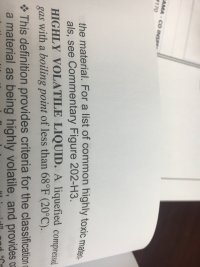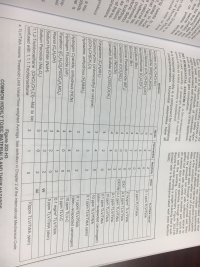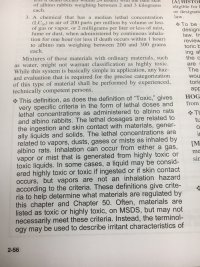Hello all,
I would like to get input from others on an issue that I frequently run into. I often am tasked with completing code reviews for buildings used for storage of agricultural products. This involves me reading through multiple Safety Data Sheets to determine the occupancy of the buildings and finding products that may create issues.
My confusion normally comes with Toxic material classification. The IBC appears to have a black and white definition when it comes to Toxic materials. Chapter 2 defines Toxic as; a chemical falling within any of the following:
1. Lethal threshold of orally administered to albino rats (paraphrased for simplification)
2. Lethal threshold of continuous contact with skin of albino rabbits (paraphrased for simplification)
3. A chemical that has a median lethal concentration (LC50) in air of more than 200 parts per million, but not more than 2,000 parts per million by volume of gas or vapor, or more than 2 milligrams per liter but not more than 20 milligrams per liter of mist, fume or dust, when administered by continuous inhalation for 1 hour (or less if death occurs within 1 hour) to albino rats weighing between 200 and 300 grams each.
Seems simple enough. Then I read Section 11 of a SDS that reads:
Example 1:
Acute
Inhalation LC50 Rat >1,000 mg/m^3, 8 hours
Oral LD50 Rat 2,840 mg/kg
Example 2:
Oral LD50 = 472 mg/kg (Rat) (IBC oral threshold is 50-500 mg/kg, I did not list above)
Dermal LD50 > 2g/kg (Rat) (note the units and specimen do not match the IBC)
Inhalation LC50 > 2.95 mg/l
Example 3:
Acute Toxicity (Oral LD50): 3,200 mg/kg (rat). May be harmful if swallowed
Acute Toxicity (Dermal LD50): No LD50 data available. May be harmful in contact with skin.
Acute Toxicity Inhalation LC50: 3.05 mg/L/4.5 hour exposure to dust/mist of undiluted material. Harmful if inhaled.
Example 4:
Acute oral toxicity: For similar material(s): LD50, Rat, female, 1,849 mg/kg
Acute dermal toxicity: For similar material(s): LD50, Rat, >5,000 mg/kg
Acute inhalation toxicity: For similar material(s): LC50, Rat, 4 Hour, dust/mist, 1.4 mg/l
Example 5:
Ingestion: Oral (LD50 Rat): >5000 mg/kg body weight
Dermal: Dermal (LD50 Rat): >5000 mg/kg body weight
Inhalation: Inhalation (LC50 Rat): >2.56 mg/l
Of the 20 materials that I have been looking at for this building, I have flagged these 5 as being toxic by IBC definition.
To add some confusion, here is a product that I did not flag as toxic:
Oral: LD50, rat: 695 mg/kg
Inhalation: LC50, rat: >5.6 mg/kg, 4 hour exposure
Dermal: LD50, rat, >5,000mg/kg (OECD Guideline 402)
Although the LC50 is not greater than 20 mg/l as the IBC requires, I assume this product is non-toxic due to the 4 hour exposure. I have found testing guidelines that somewhat explain a conversion between 1 hour and 4 hour exposure tests. Take the United Nations Part 3 Health Hazards for instance:
“Values for inhalation toxicity are based on 4 hours tests in laboratory animals. When experimental values are taken from tests using a 1 hour exposure, they can be converted to a 4 hour equivalent by dividing the 1 hour value by a factor of 2 for gases and vapours and 4 for dusts and mists.”
Thus I take the LC50 of 5.6 x 4 and get 22.4 which is now considered non-toxic by the IBC definition. The majority of the LC50 values that I see are labeled 4 hour exposure or do not list an exposure time. Because of this (and my x4 calculation) I normally do not flag a material if the LC50 is >5.
I guess my main question is, how are we supposed to accurately classify materials when the IBC does not line up with the SDS. Common “misalignments” include:
Exposure times (1 hr, 4hrs, 4.5 hrs, 8 hrs)
Units (mg/l, mg/m^3, g/l)
Tested specimen (rats, mice, rabbits)
Base on the provided information, would you (enter Ron??) classify these 6 materials as hazardous?
Thanks in advance for your time!
I would like to get input from others on an issue that I frequently run into. I often am tasked with completing code reviews for buildings used for storage of agricultural products. This involves me reading through multiple Safety Data Sheets to determine the occupancy of the buildings and finding products that may create issues.
My confusion normally comes with Toxic material classification. The IBC appears to have a black and white definition when it comes to Toxic materials. Chapter 2 defines Toxic as; a chemical falling within any of the following:
1. Lethal threshold of orally administered to albino rats (paraphrased for simplification)
2. Lethal threshold of continuous contact with skin of albino rabbits (paraphrased for simplification)
3. A chemical that has a median lethal concentration (LC50) in air of more than 200 parts per million, but not more than 2,000 parts per million by volume of gas or vapor, or more than 2 milligrams per liter but not more than 20 milligrams per liter of mist, fume or dust, when administered by continuous inhalation for 1 hour (or less if death occurs within 1 hour) to albino rats weighing between 200 and 300 grams each.
Seems simple enough. Then I read Section 11 of a SDS that reads:
Example 1:
Acute
Inhalation LC50 Rat >1,000 mg/m^3, 8 hours
Oral LD50 Rat 2,840 mg/kg
Example 2:
Oral LD50 = 472 mg/kg (Rat) (IBC oral threshold is 50-500 mg/kg, I did not list above)
Dermal LD50 > 2g/kg (Rat) (note the units and specimen do not match the IBC)
Inhalation LC50 > 2.95 mg/l
Example 3:
Acute Toxicity (Oral LD50): 3,200 mg/kg (rat). May be harmful if swallowed
Acute Toxicity (Dermal LD50): No LD50 data available. May be harmful in contact with skin.
Acute Toxicity Inhalation LC50: 3.05 mg/L/4.5 hour exposure to dust/mist of undiluted material. Harmful if inhaled.
Example 4:
Acute oral toxicity: For similar material(s): LD50, Rat, female, 1,849 mg/kg
Acute dermal toxicity: For similar material(s): LD50, Rat, >5,000 mg/kg
Acute inhalation toxicity: For similar material(s): LC50, Rat, 4 Hour, dust/mist, 1.4 mg/l
Example 5:
Ingestion: Oral (LD50 Rat): >5000 mg/kg body weight
Dermal: Dermal (LD50 Rat): >5000 mg/kg body weight
Inhalation: Inhalation (LC50 Rat): >2.56 mg/l
Of the 20 materials that I have been looking at for this building, I have flagged these 5 as being toxic by IBC definition.
To add some confusion, here is a product that I did not flag as toxic:
Oral: LD50, rat: 695 mg/kg
Inhalation: LC50, rat: >5.6 mg/kg, 4 hour exposure
Dermal: LD50, rat, >5,000mg/kg (OECD Guideline 402)
Although the LC50 is not greater than 20 mg/l as the IBC requires, I assume this product is non-toxic due to the 4 hour exposure. I have found testing guidelines that somewhat explain a conversion between 1 hour and 4 hour exposure tests. Take the United Nations Part 3 Health Hazards for instance:
“Values for inhalation toxicity are based on 4 hours tests in laboratory animals. When experimental values are taken from tests using a 1 hour exposure, they can be converted to a 4 hour equivalent by dividing the 1 hour value by a factor of 2 for gases and vapours and 4 for dusts and mists.”
Thus I take the LC50 of 5.6 x 4 and get 22.4 which is now considered non-toxic by the IBC definition. The majority of the LC50 values that I see are labeled 4 hour exposure or do not list an exposure time. Because of this (and my x4 calculation) I normally do not flag a material if the LC50 is >5.
I guess my main question is, how are we supposed to accurately classify materials when the IBC does not line up with the SDS. Common “misalignments” include:
Exposure times (1 hr, 4hrs, 4.5 hrs, 8 hrs)
Units (mg/l, mg/m^3, g/l)
Tested specimen (rats, mice, rabbits)
Base on the provided information, would you (enter Ron??) classify these 6 materials as hazardous?
Thanks in advance for your time!
Last edited:



